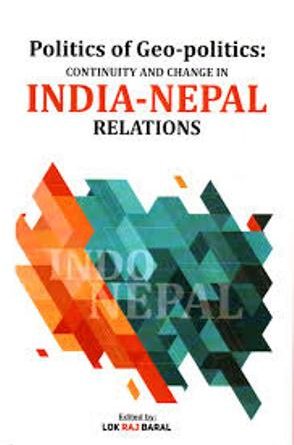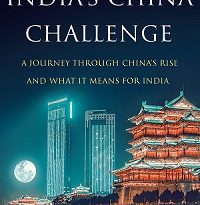Politics of Geo-politics: Continuity and Change in India-Nepal Relations; Edited by Lok Raj Baral (2018); 256p; price: 799 ISBN-10: 81-8363-138-9; Publisher Adarsh Books, New Delhi
The edited volume includes multiple perspectives of former diplomats and academicians from India and Nepal. It theorises India-Nepal relations, focussing broadly on economic, security and geopolitical relations. The book was published in 2018, and written with a perspective to highlight the importance of India-Nepal relations in the changing times.
The book traces its ideas and contents to the seminar organised in 2016 on ‘Nepal-India Relations: Continuity and Change” in collaboration with the Embassy of India. The book thereby highlights the contents of continuity and change on India-Nepal relations, tracing its genealogy from historical times to present times. In the year 2020, India-Nepal relations hit the lowest rock, and the book has reinvigorated the faith and responsibilities that the two countries share because of their historical, cultural and social relations, which are embedded in their geography.
The book expresses essential features of the India-Nepal relations and the impact of the latest developments on their relationship. China’s increasing presence in the region is a common thread running through all the chapters. Deb Mukherji and Baral focus on the overall continuity of India-Nepal relations and recognition of India’s national security interests. They have discussed the broader themes of the relations and why are they essential for both countries.
The need for autonomy is one of the foremost concern in the Nepalese mindset. This need started with the establishment of modern Nepal, when King Prithvi Narayan Shah gave out a strategic doctrine, clearly stating the need for Nepal to maintain distant relations with the British empire ruling India. The doctrine, however, showed its intention to cooperate with Indian princes and even China. The Treaty of Peace and Friendship 1950, signed between the two countries, have provided the base for stronger relations between the two countries. However, India is accused of ‘micro-managing’ Nepal’s domestic affairs.
However, Prof S.D. Muni argues that the ‘special’ relations status and the mutual security arrangements eroded over time or got undone, as discussed in the second chapter. The chapter explores how Nepal engaged with China, Pakistan and other countries since the late 1950s, making it clear that India is a ‘special’ friend, but not the ‘only’ friend. However, while exploring its relations with other countries, Nepal was not so particular about India’s security concerns. The ground for anti-Indian sentiments, aka ‘Mandale nationalism’, was framed by King Mahendra, as India supported the democratic forces in the 1960s and continues till date. The two countries need to understand that deep-rooted civilisational ties bind them together, and their strategic location imposes an obligation on both countries, where they cannot either alienate or be free of each other’s presence. Therefore, the need for India and Nepal to revive their strategic harmony is highlighted by the authors.
The book discusses Nepal’s internal instability syndrome, which has led to trends of domestic political polarisation. This topic is still pertinent, as witnessed in the year 2020, where both the leaders of the ruling party failed to agree and led to the dissolution of the House of Representatives in December 2020. To understand the current crises, the chapter underlines the history of these problems in detail. The discussion on Nepal’s internal political dynamics and India’s role is discussed in chapter five specifically, in which there is an evaluation of high-level visits of PM Dahal and PM Modi.
The running theme in all the chapters is the rising presence of China in Nepal and how it has become a tool in the hands of Nepal to use as a balancer vis-à-vis India. However, Nepal has used China’s card to counter India’s presence in Nepal since the 1950s. The chapters specifically dedicated to highlighting this trend are chapter one, two, four and five. China’s rising presence in Nepal’s economy, polity and military impose numerous concerns for India. The book explains the dynamics of the triangular relations between – India, Nepal and China. The Sinopheles stands for thefriendly stability that China provides, and the Indophobes believes India as an interventionist power. Furthermore, the book highlights this as one of the critical reasons for decreasing Nepal’s autonomy. Instead of being integrated with the world countries, Nepal’s foreign policy is shrunk to India and China.
The economic relations between India and Nepal are discussed elaborately by Prof Indra Nath Mukherji. Giving a brief background on Indian and Nepal economic structure, Prof Mukherji analyses the trends of import, export and trade balance. An interesting point here is that he also explored the trends not just between India-Nepal, but also between China-Nepal and other countries. This gives a comparative understanding of why India is an important trading partner to Nepal. India’s share in total trade is 66.7, vis a vis China’s 9.4 in 2015-15. However, India is also contributing most to Nepal’s trade deficit. Even in terms of Foreign Direct Investments, though China has cumulatively more number of projects than India, but equating it in cost, India’s investments are over Rs. 130 billion, and China’s is over Rs. 56 billion in 2016. The major issues between India-Nepal economic relations such as Tariff Rate Quotas, additional Customs duties, procedural issues for exporting agricultural goods from Nepal and many more are discussed briefly, along with the author’s comment on each of these issues. The chapter makes an interesting read for scholars who aim to understand the challenges or problems in economic relations and solutions.
The special relations vis a vis sharing an open border and their complexities are analysed in chapters ten and eleven. Uddhab P. Pyakurel elaborates on their fieldwork conducted with more than 200 stakeholders across the India-Nepal border. The report stated the challenges and the solutions for the same. The non-uniform policy at the border limits the potential of the open borders, and leads to challenges for the locals in terms of crossing borders, availing currency, importing and exporting goods, and increasing cross-border crimes. The chapter is the most comprehensive chapter of the entire book, explaining problems at each border point and detailed footnotes to provide further information. It also viewed open borders from two perspectives- security and economic. These two are the most common approaches to study border problems, therefore adds to the existing literature. The chapter by B. C Upreti further adds to the theme of open borders and their opportunities and challenges.
The book also highlights the issues of ethnicity and cross-border linkages. During King Mahendra rule, Nepal nationalism’s was identified with its three central tenets, Hill Hinduism, Nepali language and Monarchy. Mollica Dastider elaborates on the historical genesis of these identities and how the new republic was formed with post-colonial anxieties. The chapter has also explicitly mentioned the issues of adivasi janjatis and the people of plains i.e. Madhesis, who challenged Nepal’s new Republic and Constitution.
Another very interesting theme is establishing the cross-border linkages is discussed by Dipendra Jha. He highlights how there was mutual participation of two countries and their people in their democratic movements. The diverse ethnicity that exists in both countries has protested against the new Constitution. The author suggests that diverse ethnicities should not be treated as a threat but rather as a strength. Moreover, the only way to calm the divisive forces is to amend the present constitution. In present times, the voices for implementing federal democracy in its true spirit exist across the country. The people demand the right for their participation. These ethnicities have cross border linkages, which further strengthens their existence. They are tied together with bonds of ethnicity and economic dependency.
Amb Baral and other authors conclude with a positive solution to India-Nepal relations relations’ rising problems, where the two countries should look beyond conventional traditions. This solution has been emphasised by Amb Baral in his other works as well. He states that despite proximity with China, Nepal’s geographical location makes it imperative to maintain close and healthy ties with India.
Overall, the book is a valuable read for beginners who aim to understand the dynamics of India-Nepal relations. It has adopted a historical approach, where the genesis of current problems are traced to the past and discussed elaborately. Mostly in all the chapters, the underlying theme is how India-Nepal can bring back mutual trust and function in a cooperative way without challenging each other’s existence. It is essential that the two countries maintain continuity in their relations in these changing times.
The 256 pages book summarises the views of former ambassadors and diplomats but also becomes repetitive at times. Few errors in the book can be noted, namely grammatical and spelling errors; for example, calling the first Indian Prime Minister of Independent India as Jawaharlal Nehru University or writing Nepal as Nepal’s are a few errors that require the attention of the writer and the publisher. Even the referencing style and chapters structure are not the same across the book. The appendices attached at the end of the book briefly specifies the treaties that were signed, e.g. treaty of Sagauli, Nepal-India Peace and Friendship Treaty, and briefings and joint statements of meetings and high-level exchanges in a chronological manner.
Written by Cchavi Vasisht, Research Associate with Vivekananda International Foundation (VIF), New Delhi and published originally in www.vifindia.org and being reproduced with due permission from Vivekananda International Foundation, Delhi duly acknowledging their copy rights.




